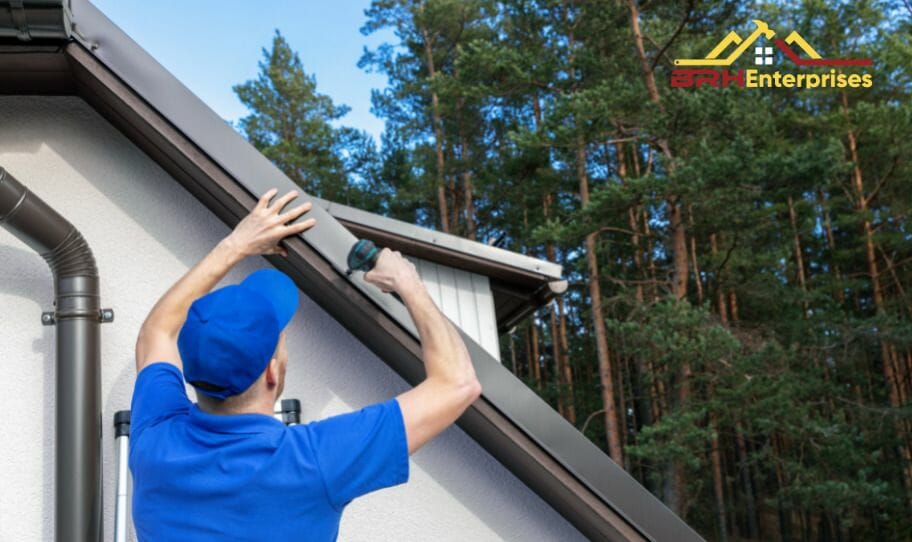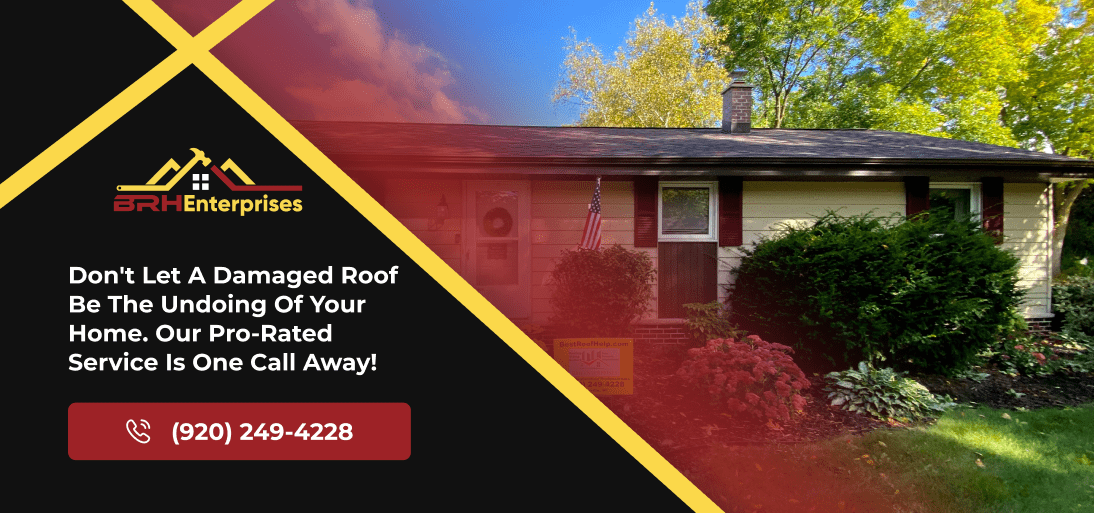Is A Drip Edge Necessary On A Roof? A Comprehensive Guide
Estimated Reading Time : 6 Min.

Thinking about repairing or replacing your roof? There’s one small roofing component you might not have heard about but really should know: the drip edge.
Ever seen that thin metal strip along the edge of a roof? That’s it! And it might just be more important than you think.
Why? Well, it keeps water from running under your roof edges, where it can cause leaks or rotting. In this guide, we’re going to tell you all about why this roofing component deserves a spot on your roof.
In this blog post, we will discuss:
- What a drip edge is
- Why it’s purpose
- How it prevents water damage
- Is it necessary
- Types of drip edge
- Drip edge installation on roofs
- Maintenance tips
What Is A Drip Edge And What Is Its Purpose?
A drip edge is a metal flashing installed at the edges of a roof. This non-corrosive strip is designed to direct water away from the fascia and into the gutter, effectively preventing water from seeping under the roof shingles and causing damage.
By extending slightly beyond the roof’s edge, the drip edge ensures that rainwater flows off the roof and away from the building’s walls and foundation, thus protecting the home’s structural integrity. It’s an essential component for preventing water damage, wood rot, and the deterioration of both the roof deck and the interior of the home.
Additionally, drip edges can help to prevent wind-driven rain from infiltrating under the roof covering, and they can block pests, insects, and small animals from entering the gap between the roof and the fascia board.
The Advantages Of Drip Edges
They offer several advantages that homeowners should consider when deciding whether to install them on their roofs. Here are some of the key benefits:
A. Protection Against Water Damage
When you skip installing a drip edge, water can sneak under shingles and fascia, causing all sorts of issues like rot and leaks. But with a proper installation, you’re channeling water right into your gutter system, keeping your roof dry and protected, further stopping any worry of water damage.
B. Prevention Of Pests
A drip edge doesn’t just save a home from water damage, it also keeps pests out. Without it, there’s a small gap between the roof deck and fascia where pests can sneak in. But with that trusty drip edge in place, you’re creating a protective seal. There won’t be any unwanted visitors in your attic or living space.
C. Protection Of Shingles
They have another important job: safeguarding your shingles from excess moisture. Drip edges prevent water from pooling and seeping beneath the shingles by guiding water away from the roof’s edge. This proactive measure helps prevent premature deterioration, sparing you from costly repairs down the road. With drip edges on duty, your shingles stay strong, reducing the need for repair.
D. Prevention Of Ice Dams
In colder climates where roofs can suffer from ice dams, a drip edge serves as a valuable defense. Ice dams form when melting snow refreezes along the roof’s colder edges. They act as a barrier, stopping water from infiltrating the roof and causing damage during the freeze-thaw cycles.
Are Drip Edges Necessary?
Now that we’ve dived into the benefits of drip edges, you may be wondering if they are a must-have for a roof. The answer is YES! These roofing components are highly recommended by most roofing contractors, and in multiple areas, they are a non-negotiable part of building codes.
The International Building Code (IBC) states that a drip edge is essential at both the eaves and gables of shingle roofs. This mandate isn’t just for show – it bolsters protection and extends the life of your roofing system.
While specific requirements can differ based on location, it’s wise to consult a roofing professional familiar with your local codes for accurate guidance.
Installing a drip edge safeguards your roof and home and ensures your roofing endeavor aligns with essential regulations and industry standards.
What Are The Types Of Drip Edge?
Profiles Type
There are multiple types of roof drip edge systems available in the market. Each of these has been denoted by a specific English alphabet letter.
- C-shaped: Just like the letter, these are shaped in a curved form that helps to drive water away. These work well even when there is no fascia board installed.
- L-shaped: L-shaped drip edges are designed as a solution to the problem of water pooling and collecting under the roof. The “L” shape helps prevent water from getting trapped on top or underneath.
- T-shaped: Last but not least is T-shaped drips. They are the most complex but are better than the other two types in terms of performance.
Materials Type
There are three common materials used to construct these roofing components:
- Copper
- Aluminum
- Galvanized Steel
Though the materials are similar, they have slight differences when it comes to function and durability. Aluminum, for instance, defends better against rust but isn’t as strong as steel. You should weigh the different materials against your desired function in your drip edge.
Drip Edges And Their Relationship With Gutters
Another common question that arises when discussing drip edges is their relationship with gutters. Drip edges and gutters work hand in hand to manage water runoff from your roof effectively. When installed correctly, it directs water into the gutter system, preventing it from causing damage to your home’s foundation or landscaping.
Suppose your home already has a gutter system in place. In that case, ensuring that the drip edge is properly integrated with the gutters is essential. This will ensure seamless water flow and optimal protection for your roof and home.
The Drip Edge Installation Process
Now that we understand the importance of drip edges, let’s look at the installation process. While hiring a professional roofing contractor for the installation is recommended, it can be helpful to have a basic understanding of how they are installed.
Materials Required: To install a drip edge, you will need the following materials:
- Roofing nails
- Roofing cement or adhesive
Preparation: Before installing the drip edge, it is important to clean and prepare the roof’s edge. Remove any debris, old roofing materials, or nails that may be present.
Positioning: Start by positioning it along the edge of the roof, ensuring that the wide, level metal flange is slipped under the first strip of roofing shingles. The outer edge of the drip edge should extend over the gutter.
Securing: Once the drip edge is properly positioned, use roofing cement or adhesive. Apply a continuous bead of cement along the top of the drip edge and press down to ensure a secure bond. Additionally, you can use roofing nails to secure the ends of the drip edge further, hammering them high up under the shingles.
Overlap: If installing multiple sections of drip edge, make sure to overlap each piece by at least an inch to ensure a continuous barrier against water infiltration.
Additional Considerations And Tips For Drip Edge Maintenance
Here are a few additional considerations and tips to keep in mind when it comes to drip edges:
- Installation By A Professional: It is crucial to have a qualified roofing contractor install your drip edge to ensure proper placement and integration with the roofing system. Professional installation will help maximize the benefits and longevity of your roof drip edge.
- Color And Style: The drip edge, fascia, and gutters are considered trim elements of your roofing system. It is important to ensure that they match each other rather than the color of the roof. Consider painting it to match your trim, or choose a color that complements your overall aesthetic.
- Regular Maintenance: While they provide added protection for your roof, it is still important to conduct regular maintenance and inspections to ensure its effectiveness. Clear any debris that may accumulate on the drip edge and inspect it for any signs of damage or wear.
- Consultation With A Professional: If you need clarification on the necessity or installation of a drip edge, it is always best to consult with a professional roofing contractor. They can assess your specific roofing needs and provide expert guidance tailored to your situation.
Final Thoughts
Drip edges offer essential defenses against water damage, pests, and potential problems that can crop up without this vital element. By steering water away from the roof’s edge and channeling it into the gutter system, it isn’t just a protector of shingles; it’s a guardian of your home’s structure. It ensures compliance with building codes while extending the life of your roofing system.
When installed and maintained correctly, a drip edge is an investment that keeps giving. It promises long-term advantages for your roof and the peace of mind you deserve.
Remember that our doors are open to you if you have any further questions about drip edges. BRH Enterprises, your trusted roofing contractor, is here to help! We’ll guide you through the process, empower you to make informed choices, and guarantee your roofing system boasts the necessary components for prime performance and protection
Always remember that a well-installed drip edge might be a small part, but it wields significant impact. Protect your home, fortify your investment, and embrace the serenity of knowing your roof is fortified with the essentials it needs.
Contact us now at 920-249-4228 to get in touch with our professionals and book a free roof inspection.



